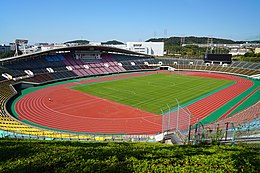This article needs additional citations for verification. (November 2015) |
The 1985 Summer Universiade, also known as the XIII Summer Universiade, took place in Kobe, Japan.
 | |
| Host city | Kobe, Japan |
|---|---|
| Nations | 106 |
| Athletes | 2,783 |
| Events | 119 in 11 sports |
| Opening | August 24, 1985 |
| Closing | September 4, 1985 |
| Opened by | Crown Prince Akihito |
| Main venue | Kobe Universiade Memorial Stadium |

Mascot
editThe mascot of the Kobe Universiade, "Unitan", designed by Osamu Tezuka, is a red-crested white crane, symbolic of Japan and a good omen. The name was chosen from some 8,000 suggestions received from throughout the country. The name is derived from a combination of 'uni' from 'Universiade' and 'tan' from the Japanese name for red-crested crane, namely 'tancho-tsuru'.
Gender test
editThe sex chromatin test was used at these games to decide on participants' gender; Spanish hurdler Maria José Martínez-Patiño was declared a man and thus ruled ineligible for the women's events.[1][2][3] In agreement with officials who suggested she fake an injury so she could withdraw without publicity, she complied. She later fought, successfully, to have that diagnosis reversed.[4]
Sports
edit- Athletics ()
- Basketball ()
- Diving ()
- Fencing ()
- Football ()
- Gymnastics ()
- Judo ()
- Swimming ()
- Tennis ()
- Volleyball ()
- Water polo ()
Medal table
edit| Rank | Nation | Gold | Silver | Bronze | Total |
|---|---|---|---|---|---|
| 1 | Soviet Union (URS) | 41 | 22 | 17 | 80 |
| 2 | United States (USA) | 25 | 21 | 23 | 69 |
| 3 | Cuba (CUB) | 8 | 8 | 5 | 21 |
| 4 | China (CHN) | 6 | 7 | 6 | 19 |
| 5 | Romania (ROM) | 5 | 10 | 6 | 21 |
| 6 | Japan (JPN)* | 5 | 3 | 7 | 15 |
| 7 | Italy (ITA) | 4 | 6 | 5 | 15 |
| 8 | Bulgaria (BUL) | 4 | 5 | 5 | 14 |
| 9 | North Korea (PRK) | 3 | 3 | 3 | 9 |
| 10 | Netherlands (NED) | 3 | 1 | 4 | 8 |
| 11 | Poland (POL) | 3 | 1 | 2 | 6 |
| 12 | South Korea (KOR) | 3 | 0 | 4 | 7 |
| 13 | West Germany (FRG) | 2 | 4 | 9 | 15 |
| 14 | Australia (AUS) | 2 | 4 | 2 | 8 |
| 15 | Nigeria (NGR) | 2 | 1 | 2 | 5 |
| 16 | Hungary (HUN) | 1 | 4 | 3 | 8 |
| 17 | Great Britain (GBR) | 1 | 2 | 3 | 6 |
| 18 | Brazil (BRA) | 1 | 2 | 2 | 5 |
| 19 | Czechoslovakia (TCH) | 1 | 0 | 1 | 2 |
| Jamaica (JAM) | 1 | 0 | 1 | 2 | |
| 21 | Canada (CAN) | 0 | 6 | 7 | 13 |
| 22 | France (FRA) | 0 | 4 | 3 | 7 |
| 23 | Yugoslavia (YUG) | 0 | 1 | 2 | 3 |
| 24 | Mexico (MEX) | 0 | 1 | 0 | 1 |
| New Zealand (NZL) | 0 | 1 | 0 | 1 | |
| Portugal (POR) | 0 | 1 | 0 | 1 | |
| Uruguay (URU) | 0 | 1 | 0 | 1 | |
| 28 | Ivory Coast (CIV) | 0 | 0 | 1 | 1 |
| Morocco (MAR) | 0 | 0 | 1 | 1 | |
| Puerto Rico (PUR) | 0 | 0 | 1 | 1 | |
| Totals (30 entries) | 121 | 119 | 125 | 365 | |
References
edit- ^ Ruth Padawer (June 28, 2016). "The Humiliating Practice of Sex-Testing Female Athletes". The New York Times.
- ^ Ljungqvist, A. (2008-04-15). "Gender Verification". In Barbara L. Drinkwater (ed.). The Encyclopaedia of Sports Medicine: An IOC Medical Commission Publication, Women in Sport. John Wiley & Sons. pp. 183–93. ISBN 9780470756850. Retrieved 2 March 2015.
- ^ Schultz, Jaime (2014). Qualifying Times: Points of Change in U.S. Women's Sport. U of Illinois P. pp. 111–12. ISBN 9780252095962.
- ^ Cole, Cheryl L. (2000). "One Chromosome Too Many?". In Kay Schaffer (ed.). The Olympics at the Millennium: Power, Politics, and the Games. Sidonie Smith. Rutgers UP. pp. 128–46. ISBN 9780813528205. Retrieved 2 March 2015.